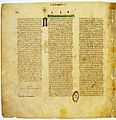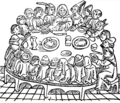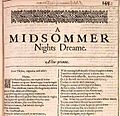Textual criticism facts for kids
Textual criticism is like being a detective for old books and writings! It's a special way of studying different copies of books or manuscripts (which are old documents written by hand).
The main goal of textual criticism is to find out what the original text looked like. It also helps us see what changes, mistakes, or additions might have been made in later copies.
This study first became popular when people wanted to understand the Bible better. But now, these detective skills are used to study many other important texts from history.
Contents
Why Study Old Texts?
Imagine you have a very old story, but all you have are copies of copies of copies. How do you know what the first, original story really said? This is the big problem that textual criticism tries to solve.
A famous expert named Paul Maas explained it well. He said that we don't have the original handwritten copies (called autograph manuscripts) from ancient Greek and Roman writers. The copies we do have were made many times over by different people. This means they might not be exactly like the first one.
The job of a textual critic is to get the text as close as possible to the original. This is true for texts from many cultures, not just Greek and Roman ones.
Finding the Archetype
A key step in this work is to find the very first copy that all later copies came from. This important first copy is called the archetype. If experts can figure out what the archetype said, it helps a lot in reconstructing the true original text.
What is a Critical Edition?
The final goal for a textual critic is to create a "critical edition." This is a special version of the text that is believed to be the closest to the original.
A critical edition also includes a "critical apparatus." This is like a detailed report that shows:
- All the evidence the expert looked at (like the names of different old manuscripts).
- The expert's thoughts and analysis about that evidence.
- A record of any parts of the text that were changed or left out, often showing which version the expert thought was best.
Related pages
Images for kids
-
A page from Codex Vaticanus Graecus 1209 shows a medieval scribe criticizing a predecessor for changing the text: "Fool and knave, leave the old reading, don't change it!"
-
Folio from Papyrus 46, containing 2 Corinthians 11:33–12:9
-
Luke 11:2 in Codex Sinaiticus
-
Canterbury Tales, Woodcut 1484
-
11th-century manuscript of the Hebrew Bible with Targum
-
Sana'a manuscripts of the Quran. Andrew Rippin has stated that the discovery of Sana'a manuscript is significant, and its variant readings suggest that the early Quranic text was less stable than previously claimed.
See also
 In Spanish: Crítica textual para niños
In Spanish: Crítica textual para niños










